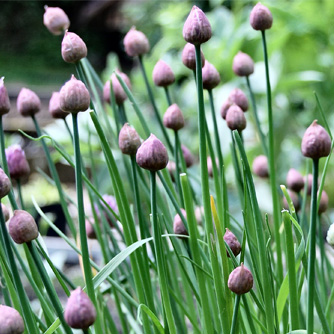Chives
BackChives are a versatile herb that belong to the onion and garlic family. This easy to grow herb adds a subtle onion flavour to salads, soups and savoury dishes and is also a popular ingredient in Asian cooking. Even the pretty summer flowers are edible and can be used as a snazzy garnish at your next dinner party!
There are two types of chives:
- Common chives (Allium schoenoprasum) with grass like foliage that is round and hollow and globe-shaped mauve flowers.
- Garlic or Chinese chives (Allium tuberosum) with flatter leaves that have a mild garlic flavour and white, star shaped flowers.
Both types grow well in the ground or in pots and can cope with extended periods indoors on a sunny window sill. In the veggie patch or in the garden, chives make a great decorative border plant.
How To Grow Chives
Plant chives in a sunny or semi-shaded position in rich fertile soil. If you have poorer soil work in some manure and compost beforehand. Chives can grow in most soil types but the added organic material will improve their performance.

Common chives coming into flower
Chives can survive dry periods but the common chives really thrive on extra water during summer to keep their growth lush. They are also frost tolerant and will die down in autumn but regrow again in spring. In milder regions they will remain evergreen.
Clumps should be divided every 2-3 years in spring or autumn to keep the plants vigorous. Use the leftover clumps to form new plantings or give away to friends.
Both types of chives can also be easily grown from seed. Sow either directly into the ground or into pots in spring, summer and autumn. In colder climates autumn sowings should only be done if the plants will be established by winter. If in doubt then stick to spring and summer sowings.
Fertilising Chives
Chives don’t like very acidic soils so apply lime or dolomite to the soil once or twice a year. Also remember to top up the bed at each spring with compost, manure or a pelleted organic fertiliser.
Liquid feeding with OCP eco-seaweed and OCP eco-aminogro every 2-3 weeks during the growing months will produce strong healthy foliage just begging to be used in the kitchen.
Pruning and Harvesting Chives
Simply cut away the leaves as you need them but be sure to give the plant time to recover. You can remove flowers to encourage a continuous production of foliage or leave them to attract beneficial insects. If you do remove them remember that they’re edible so add them into your salads and soups.
In autumn when they have almost finished dying down prune off all the leaves to just a few centimetres from the base. New foliage will appear in spring. In mild areas they won’t die down completely but at some stage during autumn/winter the older foliage will look very tatty. That’s the sign to shear it all off and let fresh new growth come through.
Pest and Diseases of Chives
There are few problems associated with growing chives but do watch out for black aphids in spring. Whitefly and mites can sometimes attack as well. Spray with an organic insecticide when pests first appear and repeat if required.
Seedlings may be attacked by snails and slugs but can be protected with OCP eco-shield.
Companion Planting with Chives
Chives are widely used as a companion plant with carrots, parsley and tomatoes. Garlic chives are sometimes planted under roses as they are said to help ward off pests.

The edible chive flower will also attract bees


